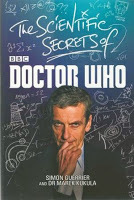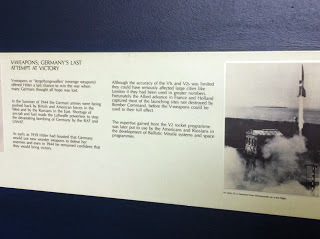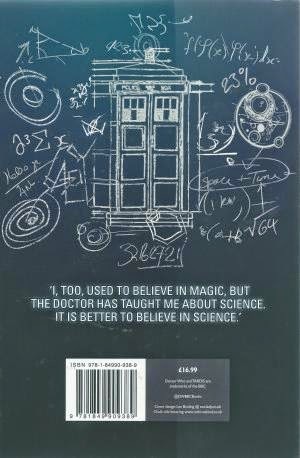Simon Guerrier's Blog, page 74
May 24, 2015
Events for The Scientific Secrets of Doctor Who
 I'll be at some events to publicise my new book,
The Scientific Secrets of Doctor Who
.
I'll be at some events to publicise my new book,
The Scientific Secrets of Doctor Who
.4 June, 6 pm
I'll be signing the book at Forbidden Planet in London, alongside by co-author Marek Kukula and short story writers Jenny Colgan, Jonathan Morris and Andrew Smith.5 June, 7 pm
Marek and I will be giving a talk at the Royal Observatory Greenwich, accompanied by a Dalek.6 June, 7.30 pm
I and the Dr will speak at the Northwich Lit Fest on "Doctor Who and the Egyptians".There'll be more events to come, which I'll post here as they're confirmed. And I've done some interviewed too. I was a guest on the Handsome Timmy D Express last week.
Published on May 24, 2015 06:07
May 22, 2015
V for Vengeance
A few hundred yards from where I live, in a gap between the terraced houses there's a children's playground. It's a regular haunt of the Lord of Chaos, and I'd vaguely wondered if the gap between the houses might have been the result of a bomb in the Second World War.
Recently, the Dr's researches on something else meant she stumbled on the fact that yes, that gap was the result of a V-2 rocket. In fact, our part of South London was especially badly hit by the Nazi vengeance weapons, the direct result of British Intelligence sacrificing my neighbourhood to save central London. They did this by convincing the Nazis that their bombs fell far north of the capital so the aim needed correcting.
I think of the people who lived in the streets around me now, and those who lived in the house where I'm typing this, in a room with a view of a garden that still contains a brick shelter. 70 years ago on VE Day, on the street where my son's playground now is, they hanged an effigy of Hitler. I can't blame them.
Of course, the V-2 later took people to the Moon - as I was surprised to find NASA discussing quite openly when I visited Cape Canaveral in 2009.






Recently, the Dr's researches on something else meant she stumbled on the fact that yes, that gap was the result of a V-2 rocket. In fact, our part of South London was especially badly hit by the Nazi vengeance weapons, the direct result of British Intelligence sacrificing my neighbourhood to save central London. They did this by convincing the Nazis that their bombs fell far north of the capital so the aim needed correcting.
I think of the people who lived in the streets around me now, and those who lived in the house where I'm typing this, in a room with a view of a garden that still contains a brick shelter. 70 years ago on VE Day, on the street where my son's playground now is, they hanged an effigy of Hitler. I can't blame them.
Of course, the V-2 later took people to the Moon - as I was surprised to find NASA discussing quite openly when I visited Cape Canaveral in 2009.
"Our guide was nicely open about the origins of American rocketry, showing us a rare example of a V2 engine while explaining what rockets like that had done to south London. He himself raised the dubious morality in pardoning the former Nazi Werhner von Braun; again, this wasn’t the kind of corporate history I’d quite expected. NASA seemed keen to challenge their own history, to ask the difficult questions."Today, the Dr took the Lord of Chaos to the RAF Museum at Colindale, and thought to snap me these pictures.
Me, "Geek Heaven", 10 November 2009.






Published on May 22, 2015 12:11
May 2, 2015
The Scientific Secrets of Doctor Who
 My new book will be out on 4 June, and this 'ere is the press release:
My new book will be out on 4 June, and this 'ere is the press release:The Scientific Secrets of Doctor WhoFull blurb and details at the Ebury website. Oh, and here's the back cover with a nice quote from Leela.
By Simon Guerrier and Dr Marek Kukula
4 June 2015
Doctor Who stories are many things: thrilling adventures, historical dramas, and science fiction tales. But how much of the science is real? And how much is fiction?
Weaving together authoratitive scientific discussion with a series of new adventures by acclaimed Doctor Who writers including Jenny T Colgan, George Mann and Jacqueline Rayner, Simon Guerrier and Dr Marek Kukula explore the possibilities of time travel, life on other planets, artificial intelligence, parallel universes and more. From the dawn of astronomy and the discovery of gravity to the moon landings and string theory, the authors show how science has inspired Doctor Who, and how, on occasion, life has mirrored art, such as the 1989 discovery of 'ice-canoes' on Triton which were featured in the 1973 episode The Planet of the Daleks.
For example, did you know...
The creation of the Cybermen in The Tenth Planet in 1966 was prompted by two American neuroscientists who argued that astronauts' bodies should be adapted to suit the conditions of space.The failure of Beagle 2 to land on Mars on Christmas Day 2003 influenced the loss of Guinevere One at the start of The Christmas Invasion.The many parallel universes that feature in Doctor Who, from Inferno to Rise of the Cybermen, are inspired by a reaction to the Schrodinger's Cat theory: that a new universe is created for each different outcome. The startling resemblance between Amelia Pond and the Twelfth Doctor and two characters from The Fires of Pompeii isn't simply due to the actors returning to the series: it might be grounded in science as well.Time Lords aren't the only beings able to regenerate - when the turritopsis dohrnii jellyfish gets ill, old, or faces danger, it can return to its childhood state as a polyp.

Published on May 02, 2015 08:55
April 17, 2015
The Founding Fathers and The Locked Room
 Those luminous persons at Big Finish have announced the contents of The First Doctor box-set out in June, what has some scribbling by me:
Those luminous persons at Big Finish have announced the contents of The First Doctor box-set out in June, what has some scribbling by me: "Big Finish are delighted to name the four new stories being released in June in the Doctor Who - The First Doctor Companion Chronicles Box Set :
The Sleeping Blood by Martin DayWhen the Doctor falls ill, Susan is forced to leave the safety of the TARDIS behind. Exploring a disused research centre in search of medical supplies, she becomes embroiled in the deadly plans of a terrorist holding an entire world to ransom – and the soldier sent to stop him.
The Unwinding World by Ian PotterOffice life is tough, the commute is a grind, nothing works quite as well as you’d like. Vicki seems to remember things being better once, before the little flat. It’s time she put some excitement back in her life. It’s just a shame the Doctor can’t help.
The Founding Fathers by Simon GuerrierThe TARDIS lands in Leicester Square in the summer of 1762. When the Doctor, Steven and Vicki find themselves locked out of the TARDIS, only one man can possibly help them. But the American, Benjamin Franklin, has problems of his own…
The Locked Room by Simon GuerrierSteven Taylor left the Doctor and the TARDIS to become king of an alien world. But it’s now many years since he gave up the throne and went to live in a cell in the mountains, out of sight of his people. He’s not escaping his past – quite the opposite, in fact. As his granddaughter, Sida, is about to discover…
Doctor Who - The First Doctor Companion Chronicles Box Set is released in June on CD and Download, and until July 1st is at a pre-order price of £20 on CD and £15 on Download. It’s part of the epic and much-loved Doctor Who - The Companion Chronicles range from Big Finish, which can be Subscribed to for savings across buying the titles separately.
Bar the first four stories, all the Companion Chronicles are available on both CD and Download, and exclusive to the Big Finish site, a CD purchase will provide access to a Download in your account too!"
Published on April 17, 2015 03:12
April 14, 2015
The Art of Doctor Who
 Out this week in shops is the The Art of Doctor Who - the latest sumptuous special edition from
Doctor Who Magazine
, "celebrating six decades of design and illustration inspired by the series."
Out this week in shops is the The Art of Doctor Who - the latest sumptuous special edition from
Doctor Who Magazine
, "celebrating six decades of design and illustration inspired by the series."It's a beautiful, comprehensive thing, and I'm thrilled to have a couple of pieces in it.
For a short feature on Doctor Who animation, I got to speak to Steve Maher, who was responsible for the look of The Scream of the Shalka and The Infinite Quest , and the two animated episodes of The Invasion .
For a longer (but it could easily have been book length!) feature on Doctor Who comics since 2000, I got to speak to Lee Sullivan, Mike Collins, John Ross, Nick Roche, Pia Guerra, Adrian Salmon, Elena Casagrande and Alice X Zhang, as well as former DWM editor Clayton Hickman and current Titan Comics editor Andrew James. (There's also sage wisdom from Martin Geraghty, but he spoke to my comrades, not me.)
But I think my favourite bit is, without me asking, an episode of AAAGH! making it into the mag, with what I think might be Nervil and Mrs Tinkle's first appearance in DWM.
Published on April 14, 2015 12:07
March 25, 2015
Doctor Who and the very Hungry Snake
Out in shops today is Doctor Who Adventures #363, which features another daft comic strip by me - "The Very Hungry Snake".
 "The Very Hungry Snake" - Doctor Who Adventures #363
"The Very Hungry Snake" - Doctor Who Adventures #363
Written by Simon Guerrier, art by John Ross,
colour by Alan CraddockAs ever, I'm delighted by the magnificent artwork by the magnificent John Ross - notching up his 1612th consecutive page of artwork for the comic strip since DWA began in April 2006. What an extraordinary achievement.
 "The Very Hungry Snake" - Doctor Who Adventures #363
"The Very Hungry Snake" - Doctor Who Adventures #363Written by Simon Guerrier, art by John Ross,
colour by Alan CraddockAs ever, I'm delighted by the magnificent artwork by the magnificent John Ross - notching up his 1612th consecutive page of artwork for the comic strip since DWA began in April 2006. What an extraordinary achievement.
Published on March 25, 2015 02:00
March 20, 2015
"That's a typical piece of fan nonsense..."

In shops now - The Essential Doctor Who: Master. Includes my interviews with Terrance Dicks, Richard Franklin and Katy Manning. I asked Terrance and Katy, on the basis of Missy, if the Master has always fancied the Doctor…
Full details at the official Doctor Who Magazine website.
Published on March 20, 2015 09:42
March 3, 2015
Irregularity signing, Forbidden Planet this Saturday
 JOIN JURASSIC LONDON AT FORBIDDEN PLANET FOR THE BEST IN CONTEMPORARY SCIENCE FICTION AND FANTASY – taking place the London Megastore on Saturday 7th March from 1- 2pm!
JOIN JURASSIC LONDON AT FORBIDDEN PLANET FOR THE BEST IN CONTEMPORARY SCIENCE FICTION AND FANTASY – taking place the London Megastore on Saturday 7th March from 1- 2pm!During the Age of Reason, the world’s greatest minds named, measured and catalogued the world around them.
They brought order and discipline to the universe. Except where they didn’t. Irregularity collects fourteen original stories from extraordinary literary voices, each featuring someone — or something — that refused to obey the dictates of reason: Darwin’s other voyage, the secret names of spiders, the assassination of Isaac Newton and an utterly impossible book.
• Tiffani Angus • Rose Biggin • Richard Dunn • Simon Guerrier • Nick Harkaway • Roger Luckhurst • Adam Roberts • Claire North • Gary Northfield • Henrietta Rose-Innes • James Smythe • M. Suddain • E.J. Swift • Sophie Waring
Come and meet the authors of this marvellous collection, have a chat, grab yourself a signed and enjoy the company – this won’t be formal event, just a chance to find some fabulous fiction!
Irregularity signing - event details on FacebookIrregularity signing - event details on Forbidden Planet's website
Published on March 03, 2015 01:09
March 2, 2015
Bananas
 The new issue of
Doctor Who Adventures
features a four-page comic strip written by me. In "Five A Day", the 12th Doctor and Clara battle giant bananas on the alien world Luna Schlosser*. Even by my usual standards, it is silly.
The new issue of
Doctor Who Adventures
features a four-page comic strip written by me. In "Five A Day", the 12th Doctor and Clara battle giant bananas on the alien world Luna Schlosser*. Even by my usual standards, it is silly.As ever, the art is by John Ross with colour by Alan Craddock, and the editor was Moray Laing. Issue #362 of DWA is in shops now.
* Luna Schlosser is, of course, also the name of Diane Keaton's character in the magnificent Sleeper (1973). It's just possible I was, ahem, inspired by one particular scene.
Published on March 02, 2015 07:25
February 3, 2015
Four non-fiction books
"The people interested in the history of comic books are not the same as the people interested in the history of the polygraph. (And very few people in either group are also interested in the history of feminism.)"
Jill Lepore, The Secret History of Wonder Woman (2014), pp. 295-6.
The Secret History of Wonder Woman is extraordinary: a compelling, strange secret history of alternative sexuality and modern times. William Moulton Marston - under the pseudonym Charles Moulton - based the superhero he created on his wife and their girlfriend - the latter the niece of Margaret Sanger, the campaigner who popularised the term "birth control". There are reasons why Wonder Woman proclaims "Suffering Sapho!" and that she's so often tied up in chains...
Marston, who invented a "lie detector" based on a test of systolic blood pressure, which later led to the polygraph, was shrouded in falsehoods - about his private life, about who in his household wrote what, about his qualifications as a psychologist. There's lots on how his threesome contrived to build a myth around him, and how for all he extolled the versions of men submitting to dominant women, he rather had it the other way round.
The epilogue is especially interesting, placing the feminist reclamation of Wonder Woman in the early 1970s amid what else what happening in the feminist movement at the time. The examples Lepore cites of "trashing" seem like a modern phenomena.
I also remain haunted weeks after finishing Do No Harm, a memoir by brain surgeon Henry Marsh. Marsh recounts a number of different cases where he has got it right or wrong - the latter always with horrific consequences. Really this is a catalogue of the terrible awfulness that life brings to us, and of human efforts to get through it. Marsh is painfully honest about his own fears and weakness, but what haunts me are his perfect turns of phrase: that all surgeons are carry with them cemeteries of the patients they have wronged; that, when facing the angry parents of a young patient, love is selfish; that doctors forget patients and patients forget doctors if everything goes well, and it's only the tragedies that linger...
Marsh's anger at the management and cut-backs, and the effect he can see them having on people's lives, echoed Nick Davies' Hack Attack, his account of the hacking scandal that he originally broke in the Guardian. At the end, he rants against a system that has removed accountability from our political systems, where even the most terrible personal tragedy has become a commodity. Like Marsh, Davies is forthcoming about his own failings - how he missed connections or said the wrong things or jeopardised his whole case. He's also good in making his account of Leveson so much about human character.
And now I am 35 pages into H is for Hawk , which is currently collecting literary prizes all over town. It turns out to echo much of these other books - how we handle tragedy and injustice and anger, how we're losing the old world in exchange for something as yet unknown. I'm not quite sure what it's about yet - so far a memoir of loss, some personal history and falconry, and the works of TH White (I am also rereading The Once and Future King) - but there's this striking moment on the process of grief, gleaned from too many books.
"I read that after denial comes grief. Or anger. Or guilt. I remember worrying about which stage I was at. I wanted to taxonomise the process, order it, make it sensible. But there was no sense, and I didn't recognise any of these emotions at all."
Helen Macdonald, H is for Hawk (2014), p. 17.
Published on February 03, 2015 12:55
Simon Guerrier's Blog
- Simon Guerrier's profile
- 60 followers
Simon Guerrier isn't a Goodreads Author
(yet),
but they
do have a blog,
so here are some recent posts imported from
their feed.



